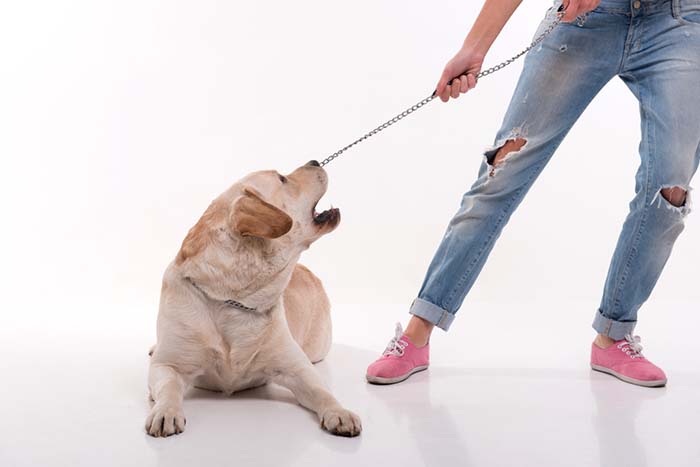10 Dog Behavior Problems and How to Deal With Them Quickly
Common dog behavior problems are the main reason why owners give up on their pets back to shelters. Knowing what type of behavioral issues to expect from your pet, how to prevent and how to deal with dog behavior problems will let you keep your pooch, and help you develop a better relationship with the dog.
1. Inappropriate Elimination
A dog urinating and defecating outside of the designated area can be caused by an underlying health condition, and in senior dogs incontinence is common. If this happens often, you may need to take your pet to the vet first to rule out any health problems.
If a medical reason is not the cause, then a dog’s inappropriate elimination may be caused by factors like territorial marking (marking behavior), anxiety, attention seeking or by the lack of proper house training. It’s a very behavior problem in dogs, most commonly in puppies, and can be easily corrected with proper housebreaking techniques or some training.
How to Avoid or Fix It:
If you’ve adopted a puppy, then timing will be crucial here. Train your pup on time and right away to prevent this behavioral issue in the future. If your dog has already been housebroken and still eliminates inappropriately, then you may need to re-train them using pee pads to avoid the mess around the house.
Some dogs are harder to house train than others because there’s more serious (psychologically) that’s causing inappropriate elimination. If that’s the case, you’ll need extensive behavior modification and help from a canine behaviorist to address this issue at its core. Your vet can also prescribe medication if retraining doesn’t work, usually in the form of antidepressants.
2. Separation Anxiety
Separation anxiety is the most well-known dog behavior problem that manifests itself in a form of destructive chewing, vocalization, house soiling and other related, similarly inappropriate behaviors. In some cases, the dog may even try to escape the home.
Separation anxiety occurs when a dog is separated from the owner and feels abandoned. Your pup will become anxious when he notices that you’re preparing to leave and will engage in destructive behavior within the first 15 to 45 minutes before and/or after the dog is left alone. This could be so the dog gets attention, or to relieve associated stress.
How to Avoid or Fix It:
General dog training methods can help with separation anxiety. For example, crate training a dog can teach your pooch not to be too attached to you and even if he has an episode he will be safe in his crate. Ignore your dog when he seeks attention while you’re about to leave, and don’t make a big deal about leaving him home – act normal.
Exercise and conditioning are good ways to deal with canine separation anxiety, while supplements and some anxiety aids can provide additional relief if training alone does not fix this. Getting your pet used to a daily routine can make him feel secure and stable. Other products that help with dog anxiety are anxiety vests and anxiety toys.
Extreme cases may require serious behavior modification and hiring a professional dog behaviorist. In her book, “I’ll be Home Soon“, famous dog behaviorist Patricia McConnell, PhD provides valuable insight into separation anxiety in dogs, and other related dog behavioral problems with extremely effective solutions.
3. Excessive Barking
Barking is the primary method of communication for dogs and each bark has a certain meaning. In that respect, barking is natural and normal for dogs; however, barking can become a problem if it is excessive or uncalled for, and a nuisance both for the owner and the neighbors.
Dogs that have this problem bark for a number of reasons. There is territorial barking, alarm barking, compulsive barking and more. Some dogs bark to get attention or out of frustration or boredom, similarly to destructive behavior. Barking is also a common sign of separation anxiety.
How to Avoid or Fix It:
You cannot stop a dog from barking if you don’t know the reason for it. To stop a dog from barking, you will first need to figure out the trigger. Once you determine why your dog barks, you address this issue by eliminating the culprit. There are a few things you can do to deal with excessive barking behavior problem:
Quiet command. Teach your dog the “Quiet” command. The easiest way to do this is to actually first teach your dog to bark on command. You can use “Speak” or “Talk” commands for it and once your dog learns this, proceed to train him to stop the barking on cue.
Your energy. Studies have shown that dogs can sense our energy and they will react to it. So do not yell at your pet when he barks, because it will be counter-productive. Instead, talk softly and calmly to try and get him to calm down.
Exercise. Excessive energy is a common cause of this behavioral problem. But if a dog is tired, he won’t have the energy to bark all the time. Take him for a walk or a run, or play more with him until he is tired.
No encouragement. Pet owners may accidentally encourage dogs to bark at some things. If you don’t want the dog barking, be aware of what you tell him to bark at, and stay consistent with those commands, or he will get confused. Do not turn this into play as well; if you react with energy to a dog’s nuisance barking, your pet may perceive it as a game.
Stop quickly. Don’t let the barking go on for a long time. The longer you let this and other dog behavior problems to go on, the harder it will be to deal with it later.
Consult. Take your dog to the vet to make sure that excessive barking behavior is not caused by a medical condition or pain which the dog is trying to express. Next, you can also consult with a professional trainer or canine behaviorist to see any issues that you may be missing.
4. Begging Behavior
Begging is not as frustrating of a problem as separation anxiety or barking for majority of pet owners because we naturally love those puppy eyes. Unfortunately, dogs know this and they know how to manipulate owners into giving them treats. This can eventually turn into a huge problem for both the owner and the dog.
Begging behavior in dogs is known to lead to dog’s obesity, digestive and stomach problems and other health issues. Begging can also become the trigger for other dog behavior problems due to your encouragement of the animal’s inappropriate behavior.
How to Avoid or Fix It:
Preventing begging in dogs is difficult mostly because their puppy eyes are irresistible. Once you get past that, it’s fairly easy to fix this behavioral issue. Simply follow one rule: never give your dog food when they beg. Ignore the dog and he will eventually give up on this behavior, realizing that begging does not result in treats.
If you can’t resist your pet’s begging behavior or find it too hard to say no, use basic commands on your pup such as “No” or “Place” before or during your meal so he can’t stare at you. In early stages, it might be necessary to confine the dog to another room.
5. Destructive Chewing
Although chewing is a normal behavior for dogs, it can also become problematic if it leads to destruction of your furniture and belongings. Puppies will often chew due to teething or curiosity, while adult dogs chew on things when they are bored, have excess energy or feel anxious and stressed out. Medical problems can also lead to excessive chewing in dogs.
How to Avoid or Fix It:
The best way to deal with a dog’s destructive chewing is to not discourage chewing altogether but use redirection: encourage your pooch to chew on the right things instead of the wrong ones. Provide plenty of dog toys he can chew on; if it’s a puppy, there are good teething toys to use.
While you’re working on fixing the destructive chewing problem, keep your personal stuff away from the dog and keep him confined or crated when you are not home. This should be a temporary method while addressing the behavioral issue. Once again, exercise can also help since it will wear off your dog’s energy and deter him from chewing.
6. Resource Guarding
Resource guarding or possessive aggression is another of those big dog behavior problems that consists of growling, barking and otherwise threatening or aggressive behavior that dogs exhibit toward other dogs or humans when they want to protect “their stuff”, such as food or toys.
Although resource guarding is considered normal for most canines, if the dog is too aggressive, it will likely to become a serious problem and can be dangerous. This is especially true if you have other pets or kids around the house.
How to Avoid or Fix It:
Teach your dog “Drop” or “Give” command. Start with boring things and objects that he isn’t interested in and reward him with a treat when he listens. Then, gradually move toward using these commands with things that he cares about, like his toys or food.
Don’t chase your dog. He will take it as a sign of play and you will only reinforce this dog behavior problem. Don’t yell or punish your dog for resource guarding. Dogs that display possessive aggression can bite if they feel threatened.
If you have multiple dogs and one is guarding his resources, particularly food, feed the two dogs separately and try to teach your dog to share his food and toys with others.
7. Digging
Digging is an instinct that all dogs have but some breeds are more prone to it, especially those used for hunting. Dogs dig for many reasons: in addition to their hunting instinct, it could be mainly out of boredom, anxiety, fear and due to excess energy.
Some dogs dig to hide their toys or bones, or to cool off in a hole. Although dog’s digging is more normal among other dog behavior problems, it can still be frustrating for owners since it can destroy their gardens or yards.
How to Avoid or Fix It:
It is important to first establish the reason why a dog is digging in order to address this issue. Work on your dog’s training and provide more exercise for him to tire him out. Provide shade in the yard and play with him often to avoid boredom and reduce stress.
If you can’t get your dog to stop digging, install a sandbox in your yard and let your pup dig there. You can either teach your dog to only dig in the sandbox, teaching him it’s his safe place, or put a fence to prevent him from digging elsewhere.
8. Pulling on the Leash
Walking a dog while he pulls on the leash is a nightmare if your dog is large and strong, and sometimes it can be dangerous for both of you. Dogs pull on a leash because they have a naturally faster pace than humans, because they get distracted by external stimuli and because they are not trained to walk beside you. This is one of the more common dog behavior problems that often is left unaddressed, but that’s a mistake.
How to Avoid or Fix It:
Training your dog to walk calmly beside you takes time and lots of rewards. While you’re working on leash pulling training, always carry a treat with you and reward your pet when he walks beside you instead of pulling.
Never let the dog pull. If he does it and you feel the leash go tight, stop walking and come to a complete standstill. Your dog will stop as well to see why you stopped. Call him to come to you. It may take a while, but your dog will eventually understand that pulling on the leash results in this annoying stopping.
Finally, you can get a front-clip harness, also known as no-pull dog harness. This harness will give you better control over your dog on walks and also prevent the dog from hurting himself.
9. Jumping Up
Even though most dogs jump up to greet people, some do it to exert dominance, their rank and height over you; or they can simply be dangerous due to their sheer size and energy. Whatever the reason for jumping may be, some owners do not mind this because it looks cute; however, this is an issue that must be addressed as it can be dangerous and also foster other related dog behavioral problems.
How to Avoid and Fix It:
The best way to stop jumping in dogs behavior is to ignore your pet when he does it, i.e. do not reward them with a reaction. Don’t acknowledge the dog at all until he puts his front paws on the ground.
Grabbing a dog’s paws or pushing him away after a jump might work for some dogs, but it usually sends the wrong message since your dog is getting the attention he was looking for and it looks like play. Teaching your pooch the “Sit” command is also a good way to stop him from jumping up.
10. Aggression
Aggression, which in some cases can also lead to dog bite attacks, is the most dangerous of common dog behavior problems. Although any dog can become aggressive, dogs with history of abuse and those bred from dogs that have aggressive tendencies have a greater chance of exhibiting aggressive behavior towards other dogs or people.
Aggression has been studied extensively in canines, and it’s a complex issue. Aggressive dogs will behave in such a manner to assert dominance or to protect their property. They can also be aggressive due to predatory instinct, fear or pain. Usual signs of aggression in dogs include snarling, showing teeth, growing, lunging and biting.
How to Avoid or Fix It:
Aggressive behavior should be treated very carefully. While there are ways you can fix or reduce this problem, it’s generally recommended that no pet owner should do it by themselves due to potential risks of injury. If possible, consult a dog trainer before doing anything else.
If your dog doesn’t have a history of aggressive behavior, it could be due to a medical issue. Take your pooch to the vet first to determine the cause of his aggression. If a medical problem is not the reason for aggression, consider getting an opinion and help from a professional dog behaviorist. Unlike with other dog behavior problems, this one is more dangerous for an inexperienced owner to address and it’s best to use a professional.
READ NEXT: Most Effective Dog Training Methods According to Science














